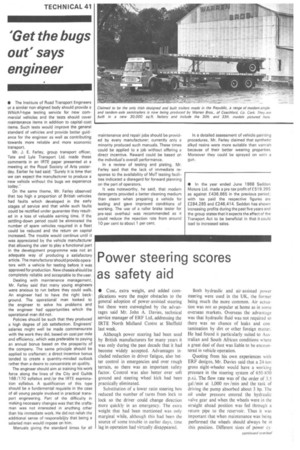"Get the bugs out' says engineer
Page 43

If you've noticed an error in this article please click here to report it so we can fix it.
• The Institute of Road Transport Engineers or a similar non-aligned body should provide a Which?-type testing serviee for new commercial vehicles and the tests should cover maintenance items in addition to capital-cost items. Such tests would improve the general standard of vehicles and provide better guidance for the engineer as well as contributing towards more reliable and more economic transport.
Mr. J. E. Farley, group transport officer, Tate and Lyle Transport Ltd. made these comments in an IRTE paper presented at a meeting at the Royal Society of Arts yesterday. Earlier he had said: "Surely it is time that we can expect the manufacturer to produce a new vehicle without the bugs we experience today."
On the same theme, Mr. Farley observed that too high a proportion of British vehicles had faults which developed in the early stages of service and that while such faults could be rectified under guarantee they resulted in a loss of valuable earning time. If the settling-down period could be eliminated the number of spare vehicles required in a fleet could be reduced and the return on capital increased. The trouble would continue until it was appreciated by the vehicle manufacturer that allowing the user to play a functional part in the development programme was not an adequate way of producing a satisfactory article. The manufacturer should provide operators with a vehicle for testing before it was approved for production. New chassis shOuld be completely reliable and acceptable to the user.
Dealing with maintenance management, Mr. Farley said that many young engineers were anxious to run before they could walk. An engineer had to have the right background. The operational man looked to the engineer to solve his problems and the engineer had opportunities which the operational man did not.
Policies should be such that they produced a high degree of job satisfaction. Engineers' salaries might well be made commensurate with the work they did, based on cost per mile and efficiency, which was preferable to paying an annual bonus based on the prosperity of the company. The same principle should be applied to craftsmen: a direct incentive bonus tended to create a quantity-minded outlook rather than a desire to concentrate on quality.
The engineer should aim at training his work forte along the lines of the City and Guilds 168/170 syllabus and/or the IRTE examination syllabus. A qualification of this type should be a fundamental requisite in the case of all young people involved in practical transport engineering. Part of the difficulty in making necessary changes was that the craftsman was not interested in anything other than his immediate work. He did not relish the additional sense of responsibillty that being a salaried man would impose on him.
Manuals giving the standard times for all maintenance and repair jobs should be provided by every manufacturer; currently only a minority produced such manuals. These times could be applied to a job without offering a direct incentive. Reward could be based on the individual's overall performance.
In a review of testing and plating, Mr. Farley said that the lack of immediate response to the availability of MoT testing facilities indicated a disregard for forward planning on the part of operators.
It was noteworthy, he said, that modern detergents provided a better cleaning medium than steam when preparing a vehicle for testing and gave improved conditions of working. The use of a roller brake tester for pre-test overhaul was recommended as it could reduce the rejection rate from around 10 per cent to about 1 per cent.
In a detailed assessment of vehicle.painting procedures, Mr. Farley claimed that synthetic alkyd resins were more suitable than varnish because of their better wearing properties. Moreover they could be sprayed on with a gun.




















































































































